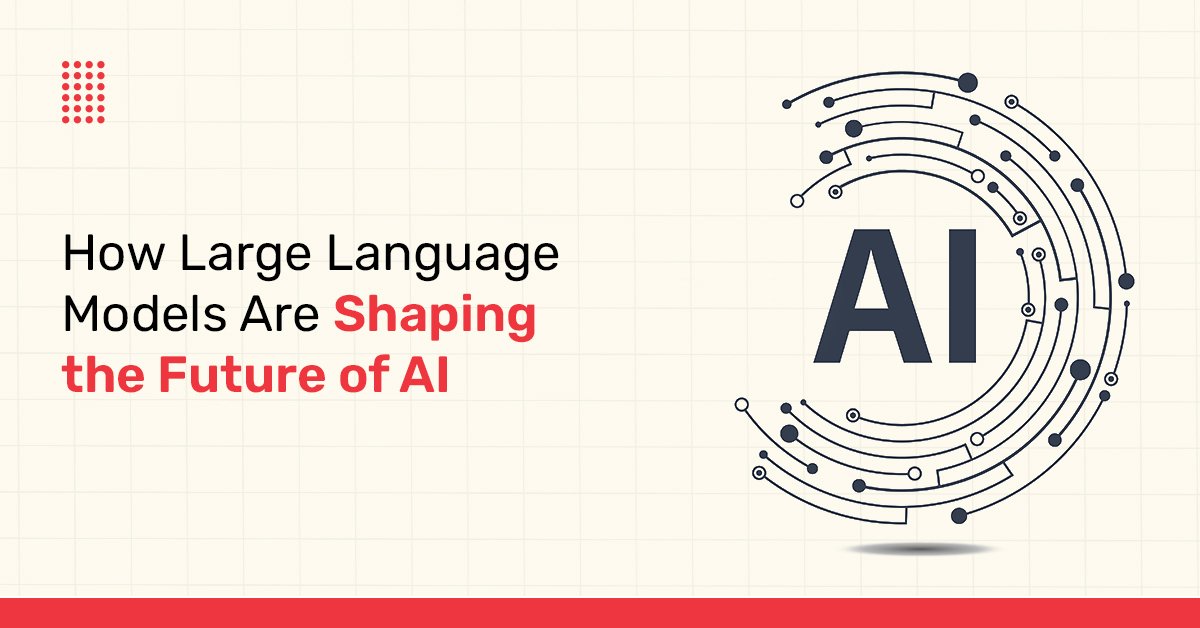The Future of AI Is Largely Determined by Large Language Models.
Introduction: The New Large Language Models (LLMs) Rise
Artificial Intelligence (AI) is changing at an accelerated rate, and among the most revolutionary inventions in the field of AI is the creation of Large Language Models (LLMs) that can boost any agency like FRD Studio. By 2025, these models will no longer be fascinating research projects but critical keys driving businesses, education, healthcare, and other daily digital interactions.
- LLMs are no simple text generation models; they are intelligent helpers, creative partners, and knowledge engines. With continued adaptations in the organizations and the society, it is important to know how these models operate and what the increasing influence entails. This blog discusses the future of AI and the world around us with the help of LLMs.
Large Language Models: What are large language models?
Large Language Models
- Large language models are advanced artificial intelligence systems that were trained on very large datasets to comprehend, process, and generate language in a manner similar to human communication. Based on the current machine learning practices, primarily the transformer architecture, these models may forecast, summarize, translate, and analyze large quantities of linguistic data.
- Among others, these are OpenAI GPT-4, Google Gemini, and Llama by Meta. LLMs can reason profoundly, learn complex instructions, and generalize across various fields—all with an extremely high level of scaling as additional data and computing capabilities are provided to them.
The Short Story of Research Labs to Real-World Solutions
- The history of LLMs started in academic laboratories; however, their potential quickly gained the attention of both tech giants and startups. The initial models were only able to achieve simple functions or speak with a limited degree of coherence.
- This was altered in 2017 with the introduction of the “transformer” model, which enables AI systems to pay attention to various aspects of the input data and is able to successfully deal with context and long-range dependencies. Performance, model parameters, and training sets have since then increased exponentially.
- In 2020, GPT-3 astonished the world with its capabilities, and a wave of even more powerful successors followed: GPT-4, Gemini 2.5, and Llama 3. Each of them introduced new capabilities, such as multimodal understanding (text, image, and video), longer context, and real-time data integration.
The Way Large Language Models Work: The Technology behind the Magic
The concept of using the LLMs can be rather confusing, but there are several basic principles that regulate their functioning:
- Tokenization: LLMs use small units (tokens) of text (they can be as brief as a character or as long as a word or phrase) to divide the text into several outputs.
- Training: The model is trained on huge data volumes consisting of books, websites, news, code, and others. It is trained to give the next word in a sentence given all the rest of the words.
- Transformer Architecture: This allows LLMs to learn to put context into practice, and therefore their responses are pertinent, coherent, and more accurate.
- Fine-Tuning: Once trained on a general set of data, a number of specific datasets can be fine-tuned to execute special purposes like contracts in the legal field, scientific studies, or after-sales customer support.
Basic Capabilities and Features of LLMs in 2025
The current state-of-the-art LLMs are multimodal and will converse with more understanding and personalization features by 2025.
Multimodality: The current LLM systems are able to accept textual, visual, and audio inputs and sometimes even video.
Contextual Awareness: These models are able to retain context and refer to context in more extended discussions or more extensive passages of text.
APIs and integration: LLMs have solid API support that enables them to perfectly fit within the business processes and platforms of the industry.
Individualized and Real-Time Results: LLMs can be able to deliver personal results, enhanced by real-time information and user context, that would increase engagement and relevance.
Significant Business and Social Transformations through Applications:
AI in Conversation and Virtual Assistants
The new generation of chatbots, digital assistants, and helpdesks is based on LLMs. They provide natural and human-like experiences, solving questions fast and booking appointments or providing tech support in the fields of healthcare, retail, and finance.
Media Automation and Content Creation
LLMs help content creators and marketers save time and effort by generating automated blogs, marketing copy, technical documentation, and video scripts. They also summarize lengthy documents and create SEO-optimized articles efficiently.
Code Generation and Software Development
LLM assists software developers, as it produces code fragments, debugs, and provides documentation, and shortens the software development cycle, minimizing possible bugs.
Tutoring, Personalized Learning, and Education
The AI-driven applications are based on LLMs to create individualized learning content, quizzes, and simulators. Learners enjoy learning through prompt feedback and instructions, and teachers automate grading and curriculum creation with the help of LLMs.
Health: Diagnostics and Patients
LLMs are used in healthcare to help in diagnostics, research, communication with patients, and summarization of medical records. The latter are assisting physicians in interpreting complicated medical information faster and communicating more effectively with patients.
Knowledge Management within the Enterprise
LLMs use large datasets to draw conclusions from them, provide summaries of research, and facilitate decision-making. They assist organizations to handle information and encourage collaboration and silo busting, hence supporting quick and superior decisions and making them the most trusted design agency in Gurugram.
Translating and Making Language Globally Accessible
The advanced translation capabilities of the LLMs are creating a world where digital content is universally accessible to communities and industries, granting power to communities and industries worldwide and making it the top design agency in Gurugram.
New Tenets of LLMs to 2025 and Beyond:
Multimodal Expansion
The latest LLMs not only work with text but also with images, audio, and video, which expands their capabilities in the creative and business processes. These multimodal models have allowed the use of such employments as automated video analysis, photo captioning, and creative story generation.
Real-Time Personalization
In 2025, the LLAIs will be able to draw live data feeds, customize responses based on personal preferences, and even learn from user feedback, which will build hyper-personalized interactions in real time.
Open Source Movement and Democratization
The open-source LLMs, including Llama by Meta and Gemma by Google, have enabled the creation and customization of state-of-the-art AI systems more than ever, leading to more innovation than ever before by companies outside of Big Tech.
Organizational Custom Foundation Models
Companies customize foundation models today with company data, building niche industry-specific LLMs and preserving sensitive data.
IoT, Blockchain, and Cloud Platforms Integration
LLMs, IoT devices, and cloud-based tools are actively automating everything from smart home control to enterprise-level analytics. Developers are also integrating blockchain to enhance transparency and trust in AI workflows.
Implications for Business, Society, and the Workforce:
Promoting Business Change:
LLMs will automate repetitive work, improve productivity, and make decisions smarter. Businesses actively use these models for research, marketing, trend analysis, and enhanced customer interactions, directly driving growth, competitiveness, and boosting the performance of design agencies in Gurugram.
Reshaping the Workforce
Monotonous and repetitive jobs are being resolved by AI, and human occupies themselves with creative, analytical, or managerial responsibilities. Simultaneously, a new set of jobs associated with AI is arising, which necessitates the ability to perform timely engineering, data management, and AI ethics.
Improving Global Cooperation and Inclusion:
Having powerful translation and customization services, LLMs can mend the cultural and linguistic gap, creating a new prospect of working globally, learning, and doing business.
Ethical, sociological, and technical:
Bias and Fairness
As LLMs are trained on large and even imperfect datasets, they may recreate or increase the current human biases. This has brought the issue of fairness into question, particularly in the hiring, legal, and healthcare applications. The solution developers are implementing includes better training data, controls, and deployment of fairness metrics.
Privacy and Security
As LLMs process more sensitive data, ensuring privacy and data security becomes increasingly critical. Developers are implementing stronger encryption, anonymization practices, and stricter regulations to ensure responsible use.
Environmental Impact
The computation of large-scale AI models is an energy-intensive process that puts the focus on energy consumption and carbon footprint issues. AI is becoming more sustainable and greener with the aid of innovations in the training process and model efficiency to minimize environmental costs.
Hallucinations, Trust, and Reliability
In some cases, LLM produces information that is plausible-sounding yet incorrect (hallucinations). Enhancing reliability is a fundamental direction, and such approaches as reinforcement learning based on human feedback, instant fact-checking, and explaining the output are under investigation.
Regulatory/Ethical Frameworks
Researchers, governments, and industry associations are working together to come up with laws and moral rules so that there is always responsible and fair use of LLMs. They are transparency, auditability, explainability, and inclusive social benefit.
Majesty of the Law School: Preparing an LLM-Fueled Future
Proficiency growth and lifelong learning
Black box thinking and dualistic thinking are necessary to succeed in the era of LLMs and stay up-to-date with their changes. The ability to be AI literate, such as having ethical consciousness, data protection, and timely engineering, will be mandatory in any profession and sector.
Engagement and participation of the people and governance
Governments and organizations are actively seeking public input to shape AI policies and address societal issues, ensuring that the benefits of AI reach everyone, not just a select few.
More intelligent, people-driven cooperation
Rather than replacing humans, LLMs now serve as valuable partners, enhancing human creativity, analysis, and judgment.
Conclusion: The Large Language Model Power
- The use of large language models has radically transformed the way humanity interacts with technology as well as how people generate content and solve complicated issues. Their increasing abilities, multimodal thought, custom results, and cross-platform device and platform integration are transforming our online landscape. However, like any technological revolution, to make the most out of them, it is necessary to manage them carefully, openly, and democratically.
The reality of the world that LLMs create is that of constantly increasing collaboration of humans and AI, in which language and intelligence do not divide but instead offer new avenues to opportunity. At this border, the prudent use of LLMs will not only determine the future of AI but also the way ahead for society as a whole.












